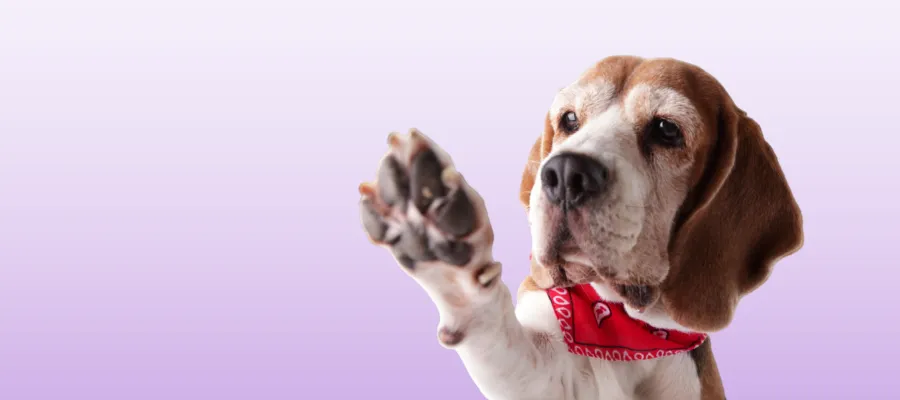Why Do Dog Paws Smell?
Posted - March 25, 2025

By Carol Bryant, Professional Pet Blogger
Why Dog Paws Smell and How to Address It
Why is it that dog paws smell? A distinct odor pet parents may smell coming from their dog’s paws may not sound concerning, but it’s a big red flag.
Dog paws are fascinating–each dog has its own unique pawprint, just as each human has its own set of unique fingerprints. Dogs have sweat glands in their paw pads, but can that cause an odor? Well, it depends.
In this article, we’ll share all the reasons your dogs paws smell, common frustrations pet parents face, and an incredible solution coming soon!
Anatomy of Dog Paws
Understanding your dog’s paws’ amazing form and function benefits all pet parents. There are several parts to every dog’s paws:
- Toe Pads (Digital Pads)
- Front and Back Pads (also called Metacarpal and Metatarsal pads)
- Carpal Pads (front paws)
- Dewclaws (in some dogs)
- Claws (or nails)
- Fatty tissue and skin (the actual paw pads)
- Ligaments and tendons
- Nerves and blood vessels
- Sweat glands
A dog’s paw is an amazing anatomical piece of architecture. Start by peeking at your dog’s paw pad and rewarding them for allowing it. You’ll see that each toe has its own small, around the paws. Dogs usually have four digital pads on each paw, plus a dewclaw pad in some.
The big central pad is called the metacarpal pad on the front paw, and the metatarsal pad on the hind paws. The carpal pads are located further up your dog’s leg behind the metacarpal pad. This behaves like a brake pad when your dog suddenly stops.
The dewclaw is seen in some dogs and acts like a thumb in people. Dogs use it to grip objects, run, and sometimes for climbing.
The nails, fatty tissue, and skin are next. These important parts act as balance, traction, insulation, cushion, and traction.
The ligaments, tendons, nerves, blood vessels, and sweat glands round out a dog’s paw. Each of these parts serves specific functions to keep paws functioning and in shape.
Why Dog Paws Smell?
Smelly dog paws have various causes. Pet parents may be stumped until your veterinarian examines your pup’s paw pad. However, these are the most common smelly paw reasons:
Bacteria
Two different types of bacteria often infiltrate dog paws–Proteus and Pseudomonas. Pet parents frequently describe a distinctive corn chip odor. This usually affects the cracks and crevices of dog feet, but it can be very stinky.
Allergies
Suppose your dog suffers from seasonal or year-round allergies, whether food or environmental; this can cause paw odor. Dogs lick their paws or itch themselves, leading to moisture buildup. As the moisture builds up, it collects in the dark areas of the paws and creates a strong odor.
Infection
If your dog is affected by a bacterial infection, odor is likely. Fungal infections are similar, but the culprit is yeast. However, as waste products and toxins grow in the area, a sour, pungent smell results.
Poor Diet
You love your dog and feed them well. If the food no longer agrees with them or is not high quality, it may impact skin, coat health, and paw pads. The weakened skin barrier allows germs to get in, and dogs may lick their paws and create an odor.
Injury
Dogs with undiagnosed paw injuries may produce paw pad odor. Checking paws regularly, especially at night, ensures you know your dog’s feet are doing well.
Paw Licking
Even if your dog doesn’t have allergies, prolonged licking can create moisture ripe for bacteria and yeast, both of which produce odor.
Overgrown Nails
One of the lesser talked about issues is overgrown paw nails. While it may not be the direct cause, nails can curl under or cause dogs to walk awkwardly. This creates pockets in the paws where dirt and bacteria may accumulate.
How Pet Parents Often Treat Smelly Paws
Once you establish your dog has a smelly paw problem, figuring out what to do can be frustrating. Some of the more common things pet parents try include:
Bathe the Dog More Often: This can sometimes help, but it will not solve the problem if there is a deeper issue.
Wipe Paws After Walks: Practicing everyday hygiene by wiping down paws after walks or outdoor play time can be helpful, but it’s not a long-term solution.
Trim Fur Around the Paws: If something gathers in your dog’s paw fur, it can be uncomfortable and lead to odor. Trimming paws is always a good idea, but ensure you have the skill to do so or ask a professional groomer.
Examine Paws Regularly: Look for burrs, cuts, scrapes, or any other wounds. If infected, there can be a smell. Any abnormalities should be reported to your veterinarian.
Change Your Dog’s Diet: You should always feed your dog a well-balanced food that meets their age and nutritional requirements.
Use Dog Booties Outdoors: Protecting your dog’s paw pads against the elements or hot sidewalks is always important. However, this may not solve the smelly paw problem.
Fortunately, ZYMOX is aware of how troublesome smelly dog paws can be. We invite you to stick around for a big announcement to help keep paws in tip-top shape without stinky odors.
In the meantime, keep your dog’s entire coat, skin, and body clean and well-hydrated with ZYMOX Shampoo and Conditioner.
Bonus tip: With skin-hydrating benefits plus antimicrobial properties, the ZYMOX leave-in conditioner can be used throughout the day as a lotion for soothing relief.
Further Reading
If your dog has skin issues, be sure to check out our other helpful content:
Unleashing Relief for Cats and Dogs Prone to Skin Issues
Skin and Hair: What Every Pet Parent Should Know

